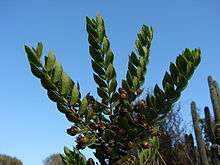Luma chequen
Luma chequen, the white Chilean myrtle, is a species of flowering plant in the genus Luma in the family Myrtaceae, native to the central Andes mountains between Chile and Argentina, at latitudes located 30 to 41° South. Synonyms include Eugenia chequen Molina, Myrtus chequen (Molina) Spreng., and Luma gayana (Barn.) Burret. Common names in Spanish include chequén, huillipeta, and arrayán blanco (white myrtle).
| Luma chequen | |
|---|---|
 | |
| Scientific classification | |
| Kingdom: | Plantae |
| Clade: | Tracheophytes |
| Clade: | Angiosperms |
| Clade: | Eudicots |
| Clade: | Rosids |
| Order: | Myrtales |
| Family: | Myrtaceae |
| Genus: | Luma |
| Species: | L. chequen |
| Binomial name | |
| Luma chequen | |
| Synonyms[1] | |
|
List
| |
It is a shrub (rarely a small tree) growing to 9 m tall, with dull grey-brown bark (unlike the smooth red bark of the related Luma apiculata). It is evergreen, with small fragrant oval leaves 0.5-2.5 cm long and 0.3-1.5 cm broad, and white flowers in early to mid summer. Its fruit is an edible dark purple berry 1 cm in diameter, ripe in early autumn.
It has been introduced as ornamental in the North Pacific Coast of the United States.[2]
Etymology
Luma is a derivation of a vernacular Chilean name for this species.[3]
External links
- "The Plant List: A Working List of All Plant Species". Retrieved February 5, 2014.
- "Luma chequen in Washington Park Arboretum" (PDF). Archived from the original (PDF) on 2009-03-24.
- Gledhill, David (2008). "The Names of Plants". Cambridge University Press. ISBN 9780521866453 (hardback), ISBN 9780521685535 (paperback). pp 243